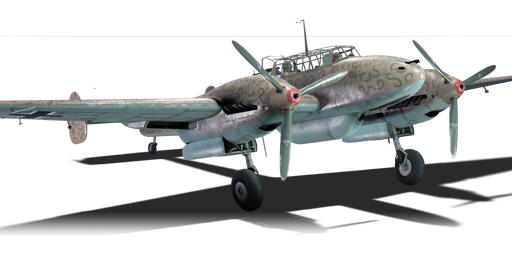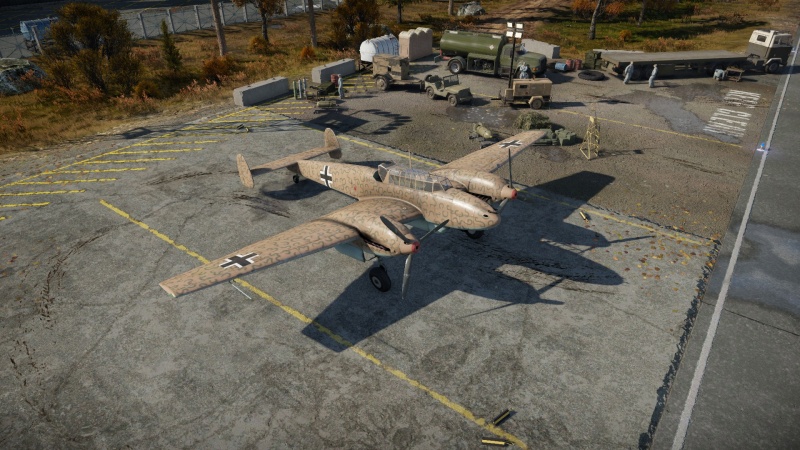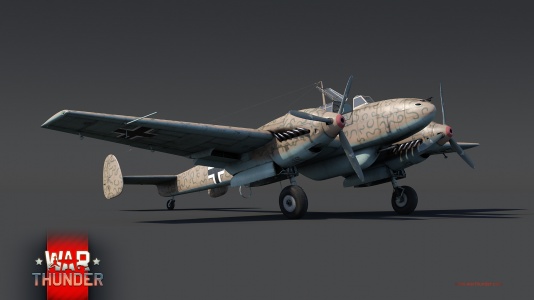Bf 110 C-6
| This page is about the German strike aircraft Bf 110 C-6. For other variants, see Bf 110 (Family). |
Contents
Description
In 1934, Hermann Goring issued a specification requirement for a long-range heavy fighter. Soon after, Messerschmitt submitted their design, the Bf 110, along with two other companies, Henschel and Focke-Wulf. The 110 was Messerschmitt's first twin-engine aircraft and was designed almost right after the Bf 109. As all three companies developed their aircraft, the RLM (German Ministry of Aviation) changed the requirements for more armament. Henschel and Focke-Wulf agreed with the requirements, but Messerschmitt rejected the new requirement and stuck with the original design. The performance loss created by the extra firepower in Henschel's and Focke-Wulf's designs led to the Bf 110 having far superior performance, which was later accepted. This marked the beginning of the Bf 110 in its long history, from the mid-1930s to the end of the war.
The Bf 110 C specifically featured the new DB 601A engines as well as a host of other changes. The air frame was revised, new propellers were added with more capability, and the cockpit enclosure was changed. The wing tips were also clipped, which reduced the wing span. By the time war broke out, squadrons were fitted with the 110 C, and they soon saw battle. The Battle of Britain would be the first major battle for the 110, and it was not good. Due to the nature of being a twin-engine fighter, the 110 could not compete with the more nimble Hurricanes and Spitfires. Many Bf 110s were lost as the war carried on, and it got so bad that they were grounded until more 110s were delivered. The Bf 110 C-6 was a minor improvement over the C-4. The main differences were the addition of a 30 mm cannon and DB 601N engines, which produced more power.
The Bf 110 C-6 was introduced as a premium reward fighter in Operation H.E.A.T event during Update 1.89 "Imperial Navy". It is quite a rare aircraft and features a unique paintjob. The Bf 110 C-6 comes armed with four 7.92 mm machine guns and a single 30 mm cannon; as well as the rear-facing turret. The 20 mm MG/FF cannons found in other Bf 110s were removed in favor of the 30 mm, which was more potent against bombers. The C-6 also lacks suspended armament, so players are relegated to using the 30 mm cannon for armoured targets. With HVAP (high-velocity armour-piercing), the 30 mm can penetrate up to 77 mm of armour which is quite good for a 30 mm. However, it lacks explosive filler, so players need to be accurate and precise when attacking enemy tanks.
General info
Flight performance
| Characteristics | Max Speed (km/h at 5,300 m) |
Max altitude (metres) |
Turn time (seconds) |
Rate of climb (metres/second) |
Take-off run (metres) | |||
|---|---|---|---|---|---|---|---|---|
| AB | RB | AB | RB | AB | RB | |||
| Stock | 525 | 507 | 10000 | 24.1 | 25.0 | 7.9 | 7.9 | 444 |
| Upgraded | 567 | 545 | 21.9 | 23.0 | 14.2 | 10.8 | ||
Details
| Features | ||||
|---|---|---|---|---|
| Combat flaps | Take-off flaps | Landing flaps | Air brakes | Arrestor gear |
| ✓ | ✓ | ✓ | X | X |
| Limits | ||||||
|---|---|---|---|---|---|---|
| Wings (km/h) | Gear (km/h) | Flaps (km/h) | Max Static G | |||
| Combat | Take-off | Landing | + | - | ||
| 715 | 320 | 467 | 438 | 290 | ~15 | ~5 |
| Optimal velocities (km/h) | |||
|---|---|---|---|
| Ailerons | Rudder | Elevators | Radiator |
| < 360 | < 350 | < 370 | > 715 |
| Compressor (RB/SB) | ||
|---|---|---|
| Setting 1 | ||
| Optimal altitude | 100% Engine power | WEP Engine power |
| 4,850 m | 1,050 hp | 1,168 hp |
Survivability and armour
- 8.5-10.5 mm Steel plates in front of the cockpit
- 5.5 mm Steel plate under the pilot
- 8-10.5 mm Steel plate behind the pilot
- 6 mm Steel plate under defensive gunner
- 8.5 mm Steel plate in front of defensive gunner
Modifications and economy
Armaments
Offensive armament
The Bf 110 C-6 is armed with:
- 1 x 30 mm MK 101 cannon, chin-mounted (60 rpg)
- 4 x 7.92 mm MG 17 machine guns, nose-mounted (1,000 rpg = 4,000 total)
Defensive armament
The Bf 110 C-6 is defended by:
- 1 x 7.92 mm MG 15 machine gun, dorsal turret (750 rpg)
Usage in battles
The Bf 110 C-6 is best suited at ground attack and bomber interception roles. The 30 mm chin-mounted cannon can load both HVAP and HE rounds giving it flexibility in both Air RB and Ground RB. The Bf 110 C-6 can intercept bombers, destroy tanks and pillboxes with its 30 mm cannon but struggles in dogfights with fighters unless it had the altitude/energy advantage. The lack of 20 mm cannons leaves the C-6 nothing to fall back on except four machine guns. The C-6 is a great ground attacker in ground battles as the 30 mm cannon can penetrate most tanks at its rank.
Manual Engine Control
| MEC elements | ||||||
|---|---|---|---|---|---|---|
| Mixer | Pitch | Radiator | Supercharger | Turbocharger | ||
| Oil | Water | Type | ||||
| Not controllable | Controllable Auto control available |
Controllable Auto control available |
Controllable Auto control available |
Separate | Not controllable 1 gear |
Not controllable |
Pros and cons
Pros:
- 30 mm chin-mounted cannon with HVAP or HE shells and 60 rounds
- 30 mm HVAP is a very capable tank killer
- Very manoeuvrable compared to other German attackers at the rank
- Flight performance are barely affected when compared to the 110 C-7
- Four 7.92 machine guns with 1,000 RPG
- Sturdy airframe and high survivability
- Armoured around the pilot and gunner
Cons:
- Lacks 20 mm cannons found on other Bf 110s
- Cannot carry bombs or rockets
- Slow acceleration and poor energy retention
- Large target
- Single 7.92 mm MG 15 dorsal turret with a limited cone of fire
- Large elevator is a large but somewhat durable target when cannons aren't involved
- Lacks armoured glass windscreen, increasing chances of pilot being injured from head-ons
History
The Bf 110 C-6 is a twin-engine heavy attack aircraft developed according to a special programme whose objective was to outfit the Bf 110 fighters with a heavy cannon armament. This modification came into existence in the spring of 1939. The aircraft was designed to be equipped with a 30 mm MK 101 cannon, while its standard-issue 20 mm cannons were dismantled for the purposes of reducing the weight and increasing fuselage space. A series of issues concerning the manufacturing of the MK 101 cannons led to the postponement of the project, but in the summer of 1940, the German government placed an order to assemble a test batch consisting of 12 C-6 aircraft. All the fighters in this batch were deployed in the Battle of France as anti-tank aircraft, as well as in the Battle of Britain to combat enemy ships and destroy enemy radars.
- From Devblog
Media
- Skins
- Images
- Videos
See also
Links to the articles on the War Thunder Wiki that you think will be useful for the reader, for example:
- reference to the series of the aircraft;
- links to approximate analogues of other nations and research trees.
External links
- [Development] Bf 110C-6: The Devourer of Ground Units
- Official data sheet - more details about the performance
| Germany strike aircraft | |
|---|---|
| Messerschmitt | |
| Bf 110 | Bf 110 C-6 · Bf 110 C-7 · Bf 110 F-2 · Bf 110 G-2 · Bf 110 G-4 |
| Me 410 | Me 410 A-1 · Me 410 A-1/U4 · Me 410 B-1 · Me 410 B-2/U4 · Me 410 B-6/R3 |
| Dornier | |
| Do 335 | Do 335 A-0 · Do 335 A-1 · Do 335 B-2 |
| Focke-Wulf | |
| Fw 190 | Fw 190 F-8 |
| Heinkel | |
| He 219 | He 219 A-7 |
| Henschel | |
| Hs 129 | Hs 129 B-2 · Hs 129 B-2 (Romania) · Hs 129 B-3 |
| Junkers | |
| Ju 87 | Ju 87 G-1 · Ju 87 G-2 |
| Foreign: | |
| USSR | ▀IL-2 (1942) |
| Germany premium aircraft | |
|---|---|
| Fighters | He 51 B-2/H · BV 155 B-1 |
| He 112 | He 112 B-1/U2 · He 112 B-2/U2 |
| Bf 109 | Flegel's Bf 109 A · Bf 109 E-7/U2 · Bf 109 G-2 |
| Fw 190 | Fw 190 A-5/U14 · Fw 190 C · Fw 190 D-13 |
| Captured | ▀Marcolin's C.R.42 CN · ▀Hawk H-75A-2 · ▀Yak-1B · ▀La-5FN · ▀P-47D-16-RE · ▀P-47D · ▀Tempest Mk V |
| Twin-engine fighters | Bf 109 Z-1 · Ju 388 J · Ta 154 A-1 |
| Jet fighters | ◄Sea Hawk Mk.100 · ◄G.91 R/4 · FFA P-16 · ◄MiG-21 SPS-K · ◊MiG-21 "Lazur-M" |
| Strike aircraft | Hs 129 B-2 (Romania) · ▀IL-2 (1942) · Bf 110 C-6 · Do 335 B-2 · He 219 A-7 · ◄Tornado IDS WTD61 · ◄Su-22M4 WTD61 |
| Bombers | Ar 196 A-3 · BV 238 · Fw 189 A-1 · He 177 A-3 · Ju 87 R-2 Libya · Ju 288 C · ▀Wellington Mk Ic |






